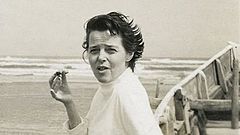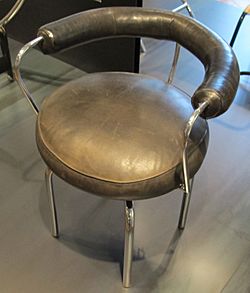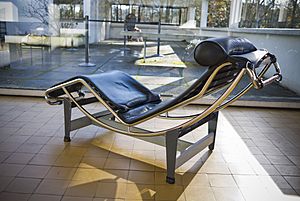Charlotte Perriand facts for kids
Charlotte Perriand (born October 24, 1903 – died October 27, 1999) was a famous French architect and designer. She believed that good design could help create a better society. Her goal was to make living spaces that were useful and comfortable for everyone. She once wrote that "the art of dwelling is the art of living." This meant living in a way that felt natural and connected to your surroundings.
Charlotte liked to spend time in a place before she started designing it. She wanted to feel the atmosphere and understand the space. This helped her create designs that truly fit the environment.
Contents
Early Life and Education
Charlotte Perriand was born in Paris, France. Her father was a tailor and her mother was a seamstress. Her art teacher noticed her talent for drawing when she was young. Her mother encouraged her to study furniture design.
In 1920, Charlotte joined the École de L'Union Centrale des Arts Décoratifs. She studied there until 1925. One of her teachers was Henri Rapin, a well-known interior designer. Charlotte also took classes at department stores and attended lectures. In 1925, her school projects were shown at a big exhibition called the Exposition Internationale des Arts Décoratifs et Industriels Modernes.
Starting Her Career
After finishing school, Charlotte Perriand quickly made a name for herself. She changed her own apartment into a modern space. It had a cool wall bar made of aluminum, glass, and chrome. She also had a card table with special cup holders.
She showed this design, called the Bar sous le Toit (Bar under the Roof), at the 1927 Salon d'Automne. Her design used lots of shiny aluminum and nickel. It also had leather cushions and glass shelves. People loved her work, and it showed her talent. She preferred designs that looked like they belonged in the "machine age." This was different from the popular style of using fancy, handcrafted wooden objects. Charlotte was one of the first women to use steel in her designs, which was usually a material used by men.
Even though her design was a big success, Charlotte wanted to do more than just create things for rich people. She wanted to work for Le Corbusier, a famous architect. She admired his ideas about making furniture that could be mass-produced and used in affordable homes.
Working with Le Corbusier
In October 1927, Charlotte applied to work for Le Corbusier. He famously told her, "We don't embroider cushions here." But a month later, Le Corbusier saw her Bar sous le Toit design. He was so impressed that he offered her a job designing furniture and interiors.
Charlotte worked with Le Corbusier and his cousin, Pierre Jeanneret. She said they were like "three fingers on one hand," working very closely together.
In 1928, she designed three chairs based on Le Corbusier's ideas. He believed a chair was a "machine for sitting." Each chair had a different purpose:
- The B301 sling back chair was for conversation.
- The LC2 Grand Comfort chair was for relaxing.
- The B306 chaise longue was for sleeping.
These chairs had frames made of tubular steel.
In the 1930s, Charlotte became more interested in designs that everyone could afford. She joined groups that supported social change. She also started using cheaper, traditional materials like wood and cane instead of expensive chrome. Many of her designs from this time were inspired by the simple furniture from Savoie, a region in France where her grandparents lived.
After working with Le Corbusier for ten years, Charlotte started her own successful career.
Time in Japan and Vietnam
After leaving Le Corbusier's studio, Charlotte worked with Jean Prouvé. He designed metal objects. When World War II started, they focused on designing military barracks and temporary housing.
In 1940, Charlotte left France for Japan. She became an official advisor for industrial design to the Japanese Ministry for Trade and Industry. She helped the Japanese government improve their designs for products to sell to Western countries.
On her way back to Europe, she was stopped because of the war. She had to stay in Vietnam for a while. During this time, she learned about woodworking and weaving. She was also greatly influenced by Eastern design. A book called The Book of Tea had a big impact on her work.
After World War II (1939–1945), people were very interested in new ways to mass-produce furniture. New materials like Formica, plywood, aluminum, and steel became popular. Charlotte and other designers showed their experimental work using these materials.
Back in Paris
When Charlotte Perriand returned to Paris in 1946, her work was in high demand. She worked on many projects, from ski resorts to student housing. She often preferred to design the interiors of buildings herself. She also worked with Jean Prouvé again. She designed the interiors and kitchens for the famous Unité d'habitation apartment building.
Some of her projects during this time included:
- The Méribel ski resort.
- The League of Nations building for the United Nations in Geneva.
- Remodeling Air France offices in London, Paris, and Tokyo.
Designing Les Arcs Ski Resort
From 1967 to 1982, Charlotte Perriand worked on the Les Arcs ski resorts in Savoie. This project brought together all her interests: making things in factories, using standard parts, and designing for mountains. It's often seen as the peak of her career.
She designed small, simple rooms because guests would spend most of their time outdoors. Instead, the buildings had large spaces that were open to nature. She used standardized bathrooms and kitchens. This made building 500 studios very quickly and efficiently.
The Chaise Longue
Charlotte Perriand was inspired by bentwood chairs. Her famous chaise longue (a long chair for reclining) has some similarities to them. When the chaise is taken off its base and placed on a flat surface, it can rock smoothly.
The chair has a thin frame and a lacquered metal base. The legs looked a bit like horse hooves. Charlotte liked this idea and even used pony skin from Parisian furriers to cover the chaise.
Charlotte wrote that their chair designs were made for the human body. They also fit the look of the architecture and setting. At first, the chair wasn't very popular because of its simple look. But as modern design became more popular, so did the chaise longue.
Personal Life
In 1926, Charlotte Perriand married Percy Kilner Scholefield. They turned their attic apartment into a modern, "machine age" space. They separated in 1930, and Charlotte moved to Montparnasse.
Later, she married Jacques Martin. They had a daughter named Pernette in 1944. Pernette worked with her mother for over 25 years.
Charlotte Perriand passed away in Paris in 1999, three days after her 96th birthday.
Timeline of Key Events
- 1927: Le Corbusier first rejects her work, but then sees her Bar sous le Toit design. He invites her to join his studio to design furniture and interiors.
- 1928: Designs three famous chairs with Le Corbusier and Pierre Jeanneret: the LC2 Grand Confort armchair, the B301 reclining chair, and the B306 chaise longue.
- 1929: Creates a modern apartment model made of glass and steel for an exhibition.
- 1930: Travels to Moscow for a design conference.
- 1932: Starts working on the Salvation Army headquarters project in Paris.
- 1937: Leaves Le Corbusier's studio. She works with artist Fernand Léger on a pavilion for the 1937 Paris Exhibition. She also starts working on a ski resort in Savoie.
- 1939: Returns to Paris when World War II begins. She designs prefabricated buildings with Jean Prouvé and Pierre Jeanneret.
- 1940: Travels to Japan as an advisor for industrial design.
- 1942: Is forced to leave Japan but gets stuck in Vietnam due to the war. She marries Jacques Martin and has her daughter, Pernette.
- 1946: Returns to France and restarts her career as an independent designer. She works with Jean Prouvé again.
- 1950: Designs a kitchen for Le Corbusier's Unité d'Habitation apartment building in Marseille.
- 1951: Organizes the French section of a design exhibition in Milan.
- 1957: Designs the League of Nations building for the United Nations in Geneva.
- 1962: Begins a long project designing a series of ski resorts in Savoie.
- 1985: A special exhibition of her work is held at the Musée des Arts Décoratifs, Paris in Paris.
- 1998: Her autobiography, Une Vie de Création, is published. Another exhibition of her work is held in London.
- 1999: Dies in Paris at age 96.
Gallery
See also
 In Spanish: Charlotte Perriand para niños
In Spanish: Charlotte Perriand para niños








